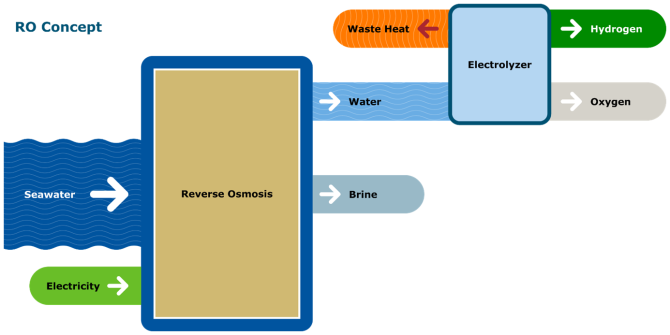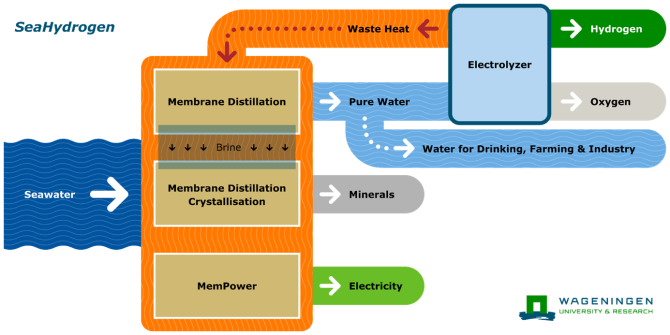
News
SeaHydrogen: Combining Hydrogen, Fresh Water, Minerals and Electricity Production from Seawater
Water producing instead of using, that is one of the key elements of SeaHydrogen, a Nexus approach that Wageningen Food & Biobased Research is launching for green hydrogen production.
The Dutch government aims for a green hydrogen economy with a production capacity of 8 GW in 2032. This asks for a substantial need on pure water as feedstock for the required electrolyzers. Currently, the solution seems to be a linear approach with Reverse Osmosis (RO): either desalination of seawater or using drinking water as a source. However, this linear approach has many disadvantages. Firstly, in both cases there is a lot of waste heat that needs to be dealt with. Secondly, desalination of seawater requires a high consumption of electricity. This waste heat and electricity issue leads an elevated carbon footprint. Thirdly, drinking water is more and more becoming a precious source.
As a preferable route, water technology experts of Wageningen University & Research advise establishing an integrated system. With this Nexus-approach, most of the disadvantages of RO are tackled, while adding various valuable utilities for society. We call this the SeaHydrogen concept. Our approach utilizes the waste heat of the electrolyzers to produce pure water and valuable minerals from seawater, as well as electricity. The pure water is not only used as feedstock for hydrogen production but is more than sufficient to create an alternative source of freshwater as well. This helps to reduce the expected freshwater shortages in the near future. Calculations and preliminary pilot studies confirm that more pure water can be produced than is needed for hydrogen production. As an additional advantage of exploiting the waste heat, less cooling of the electrolyzer is needed. This minimizes the use of cooling water and also saves energy.
Fresh water scarcity
Each year there are more reports of drinking water shortages in The Netherlands. According to Vitens we will lack 6 million m3 of fresh water in 2030 to provide 100.000 newly built houses with drinking water in the province of Gelderland. And these shortages are only expected to grow.
With this in mind, an upcoming hydrogen economy clearly adds more pressure on fresh water sources, posing additional challenges. The planned 8 GW hydrogen capacity in 2032 requires approx. 11 million m3 of pure water. If drinking water is used as a source for this, it will consume 1% of the total drinking water capacity (based on figures of 2021)of The Netherlands every year. This is twice the amount already lacking in Gelderland in 2030 alone.
Drawbacks of hydrogen production with seawater
As seawater is abundantly available, this could be the preferred source to provide hydrogen electrolyzers with pure water. The present method for this is to use Reverse Osmosis (RO) systems. However, due to the high salt content of seawater, the electricity consumption for RO is much higher compared to using fresh water as a source, resulting in a higher carbon footprint. In addition, chemicals are used to operate this process.
At the same time a brine water flow is produced with RO. Currently, this is a high salinity waste stream containing antiscalant chemicals. Discharge into the ground or at fresh surface water environments are a no-go area, as this will cause salinization of the precious fresh water sources. Discharge of brines into the sea is also not recommended as it increases local salinity at the sea border and affect marine life.
Another significant drawback of hydrogen electrolyzers is the generated waste heat. Currently there are no intentions to reuse this low-grade heat of about 80 °C . To be viable for building heating it needs to be available near an urban area, making it highly impractical for offshore hydrogen production. For onshore situations, using the waste heat only applies during the winter period. Presently, extensive cooling measures are required to dissipate the waste heat, further amplifying the demand for water.

Integrated approach with SeaHydrogen
To address all these issues, i.e., freshwater scarcity, brine discharge and waste heat dissipation, Wageningen University & Research launches the SeaHydrogen concept for hydrogen production. We advocate for a total concept (Nexus) concept instead of a linear step-by-step approach employing conventional water technologies. By employing suitable water technologies and incorporating recent advancements, the production of green hydrogen can yield pure water, extract valuable minerals, and generate electricity from seawater or other saline streams.
The concept comprises of three levels, each utilizing the waste heat of the electrolyzer. Within each stage a distinct generation of membrane distillation (MD) technologies is integrated. MD is unique in utilizing waste heat to produce high quality water from seawater with low electricity use and avoiding the use of chemicals. Unlike RO, which involves electricity costs for making water, MD utilizes waste heat to generate water without additional energy expenses.
The first stage of the concept is on the production of pure water from seawater by conventional MD. This product can be utilized as water feed for the electrolyzer. Calculations indicate the potential of producing more water with the available waste heat than needed for the electrolyzer. This surplus water can be used for other purposes, such as drinking water production, the agri-food business or industrial use, thus relieving pressure on freshwater sources.
As this first step results in a brine water stream, in a second step this flow can be concentrated further with the MD technology, again using the electrolyzer waste heat. Subsequently, salts can be recovered and separated by Membrane Distillation Crystallization (MDC) technology. Salts can be valorised for different purposes, e.g., sodium chloride for a variety of industrial and consumer products or even lithium for batteries. In 2024 WFBR and partners will make a start with investigating this Combrine concept in a Public-Private-Partnership project.
In some areas as well as in the winter season, The Netherlands needs less water production. Then, the MD installation can be reconfigured to produce electricity from waste heat, by using the MemPower approach. This concept converts heat to pressure and finally electricity at relatively high efficiency.

Multiple uses
As shown above, SeaHydrogen shows substantial benefits for a green and sustainable society in which energy and water are not only widely available, while keeping the costs in balance. In addition to centralized applications in The Netherlands and abroad, the SeaHydrogen concept can also be applied on a local level and with other heat and/or water sources. If residual heat of 60 °C or higher is available, there is potential to produce fresh water, valuable minerals and electricity from various aqueous feedstocks.
WUR strongly recommends that both policy makers and the water technology sector embrace this approach as they work together towards providing water, clean energy, and minerals for all. The suggested strategy restores hydrogen to its rightful place as one of the most significant feasible measures towards a green economy.